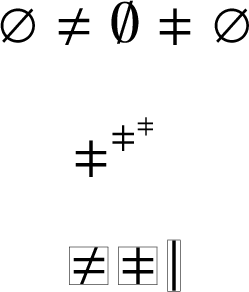
Both are usually used for "isomorphic" which means "the same in whatever context we are." For example "geometrically isomorphic" usually means "congruent," "topologically isomorphic" means "homeomorphic," et cetera: it means they're somehow the "same" for the structure you're considering, in some senses they are "equivalent," though not always "equal:" you could have two congruent triangles at different places in a plane, so they wouldn't literally be "the same" but their intrinsic properties are the same. I’m going to be assuming there exists a PHP function called do_thing, and your question across all our scenarios is not to worry what do_thing does–nothing, it’s a fake function–but just tell me if it will be called or not.The notations $\cong$ and $\simeq$ are not totally standardized. The bang operator ( !) is pretty easy, so we’ll start there. WordPress conditional tags are generally very easy to read, so if you’re not familiar this shouldn’t prove a big obstacle.

We’re going to use a simpler situation to understand PHP conditional logic first, but then we’ll layer in some WordPress conditional tags. Examples of Using PHP Operators: ! just & and || in strange placesĮnough with the highfalutin words, let’s see some code. What this means is that “the sun equals the moon” is a false statement, but “the sun not equals the moon” is a true statement. It’s important to know that “not” ( !) in logical syntax doesn’t “turn it off” but instead “flips it.” So “not true” becomes false, and “not false” becomes true. Unlike with & and ||, there exists no linguistically-written version. The last thing you need to know to claim you have a robust boolean language is the presence of the “not.” In PHP, you’ll only write that with a “bang” or “exclamation point,” !. It means “if the things that surround me are both true, and never else.” Unless you’re looking to impress people, I’d avoid this, as people aren’t in the habit of reading it.) Bang ( !) is NOT to be forgotten It’s one I’ve never seen outside of tutorials. This is the rarest PHP logical operator of all. (Even more rare, there exists an “exclusive or” operator in PHP, written xor. Again, I didn’t realize until writing this article that or was valid PHP, so you should get used to reading and writing ||. What we see most frequently is instead the “double pipe” || operator.
Not equal symbol in php archive#
Like I said, in WordPress themes that might be “if this is a single post entry, or if it’s an archive page.” And like with and above, you can actually write valid PHP code with a simple: or where you mean that.īut, just the same, we almost never see that in the wild. Now for OR or ||: An Alternative Logical OperatorĪnother core idea of boolean logic with PHP is “or.” Sometimes there are two preconditions, where either being satisfied makes a thing acceptable to us. Long story short: use & when you want to say and in PHP code.
The issue is that and behaves a little differently than most of us think, so it might surprise you from time to time in it’s execution. In fact, I can count on one hand the times I’ve read PHP that used and (or or or xor), and many of them were while I was writing this article. Why was I surprised that you can say “and” with both the & operator and the keyword and? Because no PHP code I’ve ever read has used the latter, and, format.

It evaluates a little different, but the language lists it prominently in its documentation on logical operators. In fact (as someone who’s been writing PHP for 15 years, this surprised me) you can write and in PHP. These two pretzels serve the same role of and in some other programming languages you might be used to. In short, you say a PHP “and” with a double ampersand symbol ( &).
Not equal symbol in php how to#
And to understand that syntax, we must know how to say “and” and “or”, so let’s get to it. So a lot of WordPress PHP code ends up simply being rules like ‘if the data I’m showing is recent, and I’m showing a “page” post type, don’t show the date on the page.’ These rules must be written in a much more syntactically exact way than we speak them, but the principle is the same. (That’s the role of the “template hierarchy” in WordPress, if I just blew your mind.) At the risk of oversimplifying, in WordPress we simply store specific data, and then build simple little machine (called “WordPress themes”) to display that data to specific people in specific way under specific conditions. To the surprise of many people afraid of programming, a lot of what you do when programming is create and solve simple logic puzzles. Why PHP Logical Operators Matter & What They Are


 0 kommentar(er)
0 kommentar(er)
